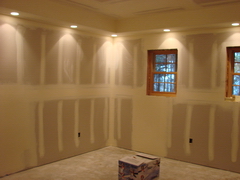» Need Electrical Help? Ask the Electrician
Basement Lighting and Plugs

|
By Dave Rongey
© By: Dave Rongey |
How to Wire Basement Lighting and Plugs
Wiring Basement Lighting and Plugs.
I'm selling my house. The new buyers had a home inspection, which turned up the following. The previous owners had the basement finished. The bedroom outlets do not work when the room light switch is turned on. The outlets go live when the light is turned off. What should I check? Is this a simple fix?
Thanks Steve
Hi Steve - Great Electrical Repair Question!
I must ask you - does a light actually come on when the switch is turned on?
My first thought is that the switch is upside down. If a ceiling light actually goes on and the switch is in the right position then there is some other checks needed to be made - Such as: Is this a single switch, in other words is there more than one switch that controls the light? I ask this because there may be another switch, making it a 3-way switch configuration and in that case the plugs could have been wired into the switch wiring incorrectly.
Most single switches have on and off printed or the words molded into the handled of the switch. 3-Way switches do not show an indication of being in an on or off position.
Has it always been like this as long as you have been in the home? Let me know if this helps and what you find.
From: Steve.
Dave, I finally made it back to the basement to check this out.
Yes, if the switch is flipped on, the over head light does come on (and the outlets go dead). It has always been this way (I assume since I never changed it).
Here's what I see - It is a 3-way switched used where there is only 1 point to turn off/on the overhead light.
There are 3 set of wires - power in, wire to the light, and wire to the outlet (6 wires total). The hot wires are to the 3 places in the 3 way switch, the neutral wires are wound together and capped (as are the grounds).
I'm not an electrician, but this looks FUBAR. A friend thought I could install a double switch and solve - one switch powers the outlets, the other the overhead light.
The Safest Way to Test Electrical Devices and Identify Electric Wires!The Non-Contact Electrical TesterThis is a testing tool that I have had in my personal electrical tool pouch for years, and is the first test tool I grab to help identify electrical wiring. It is a Non-contact tester that I use to easily Detect Voltage in Cables, Cords, Circuit Breakers, Lighting Fixtures, Switches, Outlets and Wires. Simply insert the end of the tester into an outlet, lamp socket, or hold the end of the tester against the wire you wish to test. Very handy and easy to use.
The Quickest Way to Check for Faulty Electrical Wiring!The Plug-In Outlet TesterThis is the first tool I grab to troubleshoot a problem with outlet circuit wiring. This popular tester is also used by most inspectors to test for power and check the polarity of circuit wiring. It detects probable improper wiring conditions in standard 110-125 VAC outlets Provides 6 probable wiring conditions that are quick and easy to read for ultimate efficiency Lights indicate if wiring is correct and indicator light chart is included Tests standard 3-wire outlets UL Listed Light indicates if wiring is incorrect Very handy and easy to use.
Strip Off Wire Insulation without Nicking and Damaging the Electric Wire!The Wire Stripper and Wire CutterMy absolute favorite wire stripping tool that I have had in my personal electrical tool pouch for years, and this is the tool I use to safely strip electrical wires. This handy tool has multiple uses: The wire gauges are shown on the side of the tool so you know which slot to use for stripping insulation. The end of the tool can be used to grip and bend wire which is handy for attaching wire onto the screw terminals of switches and outlets.. The wire stripper will work on both solid and stranded wire. This tool is Very Handy and Easy to Use. |
||
Residential Electrical Parts and AccessoriesLight Switches 120volt Outlets Circuit Breakers Electrician Tools Voltage Testers |














